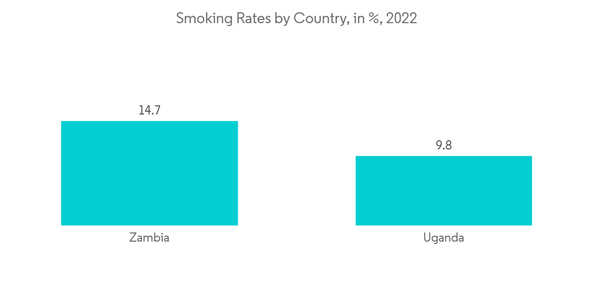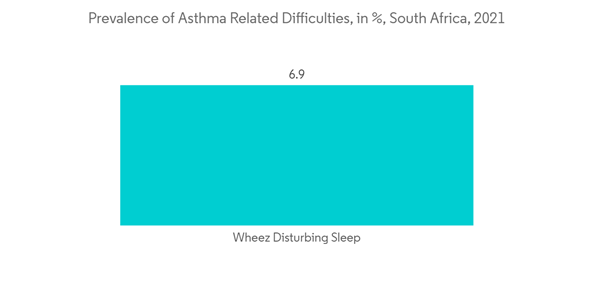The COVID-19 pandemic accelerated the demand for respiratory monitors worldwide as the disease causes severe respiratory syndrome. The South African healthcare system was majorly impacted during the pandemic due to delays in precautions taken by the South African government, lack of PPE kits, and other COVID-related equipment, such as spirometers and pulse oximeters. However, at the peak of the COVID-19 pandemic, when the number of sufferers increased drastically, there was an immediate increase in the production, import, and deployment of respiratory products, such as pulse oximeters, ventilators, and other devices. Thus, the market studied witnessed significant growth during the pandemic. However, post-covid, there was a slight decrease in the demand for respiratory monitoring devices, and the market has currently reached the pre-pandemic level. It is believed to witness healthy growth in the coming years.
In recent years, the awareness regarding disorders and their management drastically improved in developing regions, such as the Middle East and Africa. The development of advanced technologies also helps market growth in the region. More importantly, economic development in the region led to increased pollution levels in cities, exacerbating chronic respiratory illnesses. These factors help market growth in the region.
The increasing burden of respiratory diseases across the region propels the market growth. For instance, as stated by the NSW government, as of 2021, a total of 2,578 laboratory-confirmed cases of Middle East respiratory syndrome (MERS) were documented internationally. Saudi Arabia reported the most cases, with 2,178 cases and 810 associated deaths. Furthermore, the rising prevalence of COPD across the region augments the demand for respiratory monitoring, thus contributing to market growth. For instance, the National Health Institute's article published in March 2022 suggests that the prevalence of COPD in sub-Saharan Africa was around 24% in 2021. Hence, owing to rising respiratory diseases in the region, the market studied is believed to grow in the future.
However, reimbursement concerns regarding respiratory monitoring devices are expected to hinder the market growth.
MEA Respiratory Monitoring Market Trends
Pulse Oximeter Expected to Witness Strong Growth
A pulse oximeter is a noninvasive device that estimates the amount of oxygen in the blood. Pulse oximeters became the most common device used for respiratory monitoring across the Middle East and Africa due to the COVID-19 pandemic.Asthma and COPD are two of the major diseases that cause a high burden to the healthcare systems in the Middle East and Africa. The rising prevalence of these diseases propels the demand for monitoring devices. Asthma poses a severe burden in Middle Eastern countries. For instance, the mortality rate for Asthma in Uganda, which is 19 fatalities per 1000 person-years, is 90 times that of the United Kingdom. A study by the Journal of the Pan African Thoracic Society (JPATS) stated that in Uganda, in 2021, a study was conducted to understand the effect of Asthma on the general population. The study revealed that only 33% of Asthma patients had the disease in control, and the lack of awareness about monitoring the disease increased the severity of the disease. A pulse oximeter is a cost-effective solution for respiratory monitoring.
The same study also mentioned that the overall burden of Asthma and COPD in sub-Saharan Africa is on the rise. Thus, there is a growing demand for monitoring devices across the region which is believed to propel the growth of the pulse oximeter segment, as these devices are cost-effective, easy to use, and suits the needs of all types of patients.
South Africa is Believed to Witness Significant Share in the Market
South Africa is one of the leading countries in the Middle East and Africa region. For the market studied, South Africa is believed to hold a strong share. The medical device industry in South Africa is still under development and the country relies mostly on the import of medical devices from other countries.The market for respiratory monitoring devices in South Africa is majorly driven by an increasing prevalence of respiratory diseases such as Asthma and COPD. The COVID-19 pandemic has created huge awareness among the general population about respiratory monitoring devices. As per the study by the Department of Paediatrics and Child Health, in 2021, around 17.6% of children suffering from Asthma were hospitalized. The severity of the diseases was due to the lack of awareness among the people. Additionally, the same study revealed that in the coming years, the prevalence of Asthma is expected to rise which is believed to propel the market growth.
Furthermore, as per the National Institute of Health 2022 data, there is a rising number of people smoking across South Africa. For the year 2021, there was around 20% of the African population counted as chain smokers. With increasing smoking prevalence in South Africa, there is a rise in diseases such as COPD which is expected to contribute to the market growth.
MEA Respiratory Monitoring Industry Overview
Most global players are present in the Gulf Cooperation Council (GCC) region of the Middle East and Africa (MEA), owing to factors such as economic growth in the last few decades. The African region consists of some developing and underdeveloped countries. Healthcare systems in these countries are not well structured and stable due to the lack of essential funds. Some key players in the Middle East and African respiratory monitoring market include Medtronic, Draegerwerk, Resmed, Koninklijke Philips N.V., and GE Healthcare, among others.Additional Benefits:
- The market estimate (ME) sheet in Excel format
- 3 months of analyst support
This product will be delivered within 2 business days.
Table of Contents
Companies Mentioned (Partial List)
A selection of companies mentioned in this report includes, but is not limited to:
- Airsep Corporation
- Medtronic PLC
- Dräger
- GE Healthcare
- Hamilton Medical
- Getinge (Maquet)
- Koninklijke Philips N.V.
- Resmed Inc.
- Siemens Healthineers AG
Methodology

LOADING...










